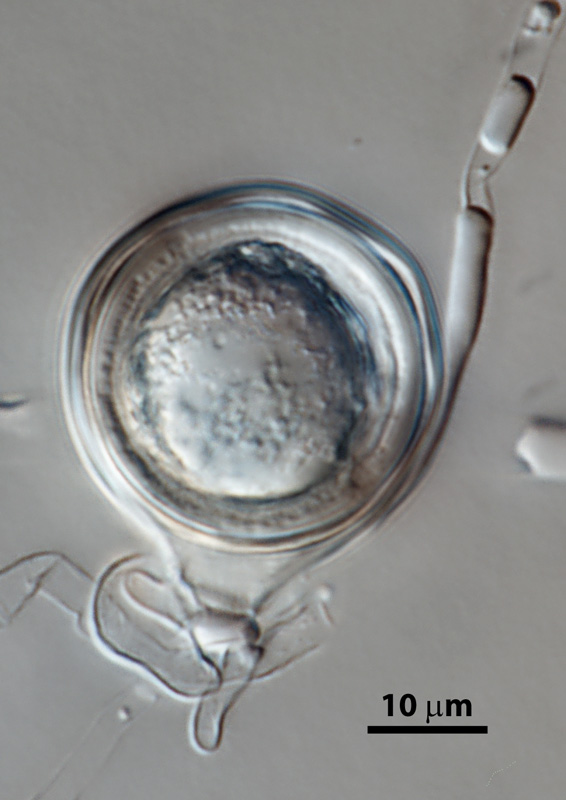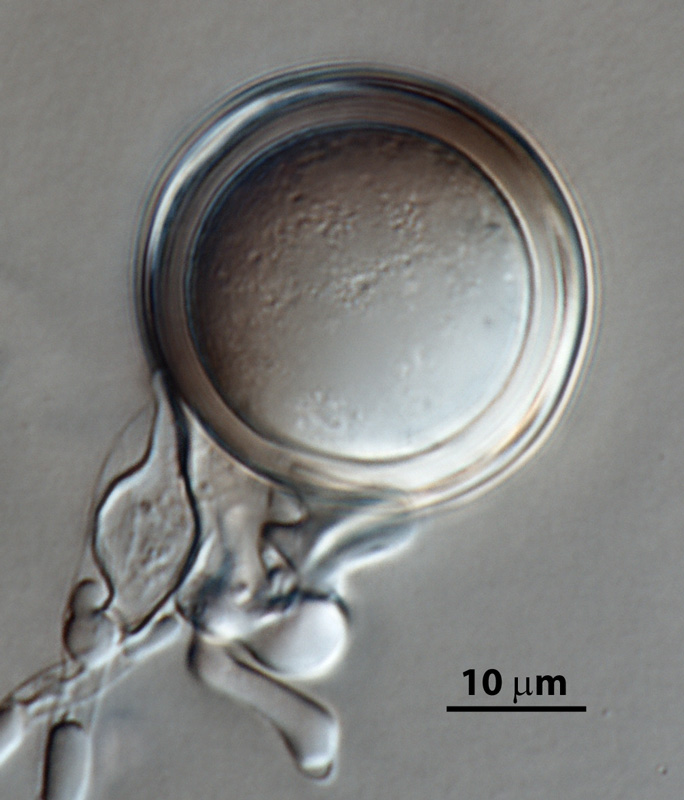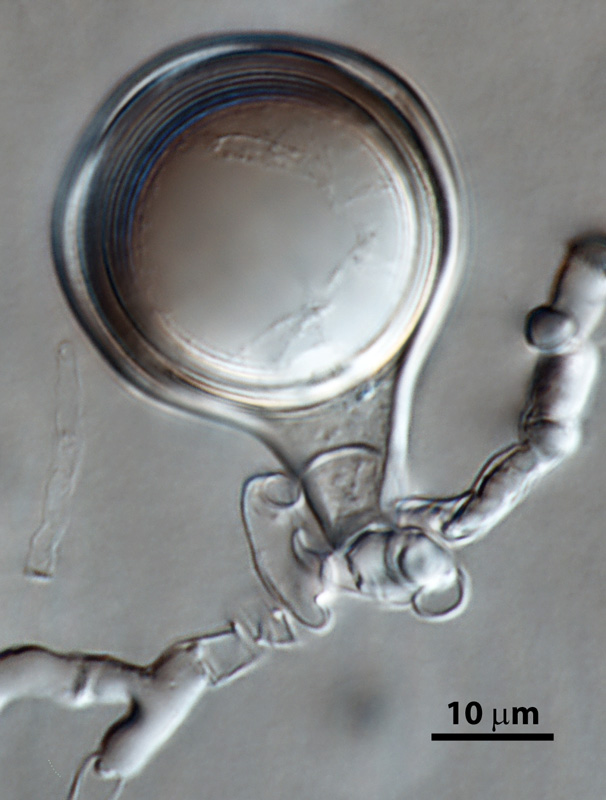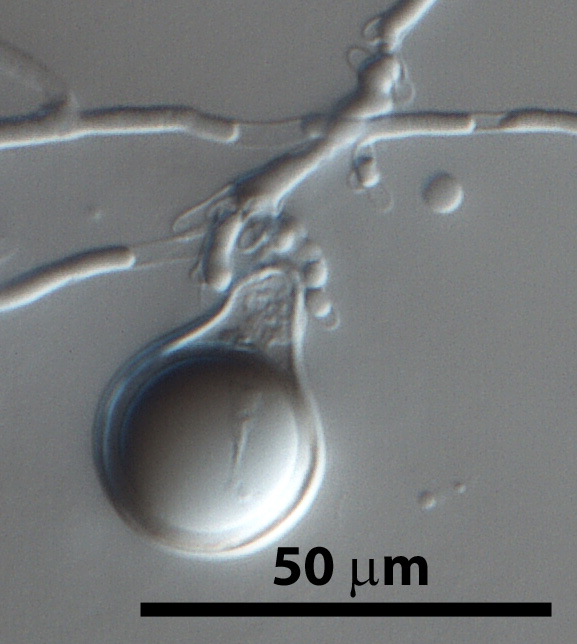Phytophthora europaea
|
Phytophthora spp. in subclade 7a: portion of the seven-loci ML phylogeny featuring the type cultures of 212 described species (by T. Bourret). Notice the position of P. europaea Ex-type CBS 109049 = S&T BL 37G. Gloria Abad, USDA S&T.
|
|
Phytophthora spp. in subclade 7a: Morphological Tabular key (PDF) and Tabular key legends (PDF) in IDphy2 KEY SECTION. Notice the data of P. europaea Ex-type CBS 109049 = S&T BL 37G. Gloria Abad, USDA S&T.
|
|
Phytophthora europaea (CPHST BL 37G) colonies of the ex-type grown for 7 days on (a) V8® Agar, (b) potato dextrose agar, and (c) malt extract agar; photo by Krysta Jennings and Leandra Knight, USDA-APHIS-PPQ |
|
Phytophthora europaea (CPHST BL 37G) sexual phase of the ex-type (a–e); photos by Vickie Brewster, USDA APHIS PPQ |
|
Phytophthora europaea (CPHST BL 37G) asexual phase of the ex-type with hyphal swellings; photo by Vickie Brewster, USDA APHIS PPQ |
|
Phytophthora europaea (CPHST BL 37G) sexual phase of the ex-type: plerotic oospore, oogonium with tapered base, and paragynous antheridium; photo by Vickie Brewster, USDA APHIS PPQ. |
|
Phytophthora europaea (CPHST BL 37G) sexual phase of the ex-type: plerotic oospores, oogonia with tapered bases, and paragynous antheridia; photo by Vickie Brewster, USDA APHIS PPQ. |
|
Phytophthora europaea (CPHST BL 37G) sexual phase of the ex-type: plerotic oospores, oogonia with tapered bases, and paragynous antheridia; photo by Vickie Brewster, USDA APHIS PPQ. |
|
Phytophthora europaea (CPHST BL 37G) sexual phase of the ex-type: plerotic oospore, oogonium with tapered base, and paragynous antheridium; photo by Vickie Brewster, USDA APHIS PPQ. |
|
Phytophthora europaea (CPHST BL 37G) sexual phase of the ex-type: plerotic oospore, oogonium with tapered base, and paragynous antheridium; photo by Vickie Brewster, USDA APHIS PPQ. |
|
Phytophthora europaea (CPHST BL 37G) sexual phase of the ex-type: plerotic oospore, oogonium with tapered base, and paragynous antheridium; photo by Vickie Brewster, USDA APHIS PPQ. |
|
Phytophthora europaea (CPHST BL 37G) sexual phase of the ex-type: older golden-brown plerotic oospore, oogonium with tapered base, and paragynous antheridium; photo by Vickie Brewster, USDA APHIS PPQ. |
|
Phytophthora europaea (CPHST BL 37G) sexual phase of the ex-type: older golden-brown plerotic oospore, oogonium with tapered base, and paragynous antheridium; photo by Vickie Brewster, USDA APHIS PPQ. |
Name and publication
Phytophthora europaea E.M. Hansen & T. Jung (2002)
Jung T, Hansen EM, Winton L, Osswald W, and Delatour C. 2002. Three new species of Phytophthora from European oak forests. Mycol. Res. 106: 397–411.
Corresponding author: jung@bot.forst.tu-muenchen.de
Note: described with Phytophthora psychrophila and Phytophthora uliginosa
Nomenclature
from Jung et al. (2002)
Mycobank
Etymology
‘Europaea’ commemorates the international research project supported by the European Union (‘Pathoak’ FAIR 5-CT97±3926) during which most isolates used for this species description were recovered.
Typification
Type: FRANCE, Lorraine, Forêt d'Amance, isolated from rhizosphera of Quercus robur, April 1998, T. Jung (OSC 86347)
Ex-type: CBS 109049, IFB-EUR 2
Sequences for ex-type in original manuscript: Phytophthora europaea CBS 109049, IFB-EUR 2 = ITSrDNA AF449493
Ex-type in other collections
(ET) CBS 109.049, NRRL 64166, WPC P10324, IFB-EUR 2, S&T BL 37G (Abad), 62A2 (Hong)
Molecular identification
Voucher sequences for barcoding genes (ITS rDNA and COI) of the ex-type (see Molecular protocols page)
Phytophthora europaea isolate CPHST BL 37G (= P10324 WPC) = ITS rDNA MG865488, COI MH136884
Voucher sequences for Molecular Toolbox with seven genes (ITS, β-tub, COI, EF1α, HSP90, L10, and YPT1
(see Molecular protocols page) (In Progress)
Voucher sequences for Metabarcoding High-throughput Sequencing (HTS) Technologies [Molecular Operational Taxonomic Unit (MOTU)]
(see Molecular protocols page) (In Progress)
Sequences with multiple genes for ex-type in other sources
- NCBI: Phytophthora europaea CPHST BL 37G
- NCBI: Phytophthora europaeae P10324
- NCBI: Phytophthora europaeae CBS 109049
- EPPO-Q-bank: Phytophthora europaea CBS 109049
- BOLDSYSTEMS: Phytophthora europaea PHYTO031-10 = P10324 (barcoding COI & ITS)
Position in multigenic phylogeny with 7 genes (ITS, β-tub, COI, EF1α, HSP90, L10, and YPT1)
Clade 7a
Morphological identification
adapted from Jung et al. (2002)
Colonies and cardinal temperatures
Colony colony:
assemblage of hyphae which usually develops form a single source and grows in a coordinated way
morphology after 7 days on PDA, V-8, and MEA with no distinct pattern. Minimum growth temperature 3°C, optimum 21°C, and maximum 27°C.
Conditions for growth and sporulation
Sporangia and hyphal swellings are produced in non-sterile soil extract water cultures.
Asexual phase
SporangiaSporangia:
sac within which zoospores form, especially when water is cooled to about 10°C below ambient temperature; in solid substrates, sporangia usually germinate by germ tubes
nonpapillatenonpapillate:
pertaining to the production of a non-distinct, or inconspicuous, papilla at the distal end of the sporangium (cf. papillate and semipapillate)
, persistentpersistent:
pertaining to sporangia that remain attached to the sporangiophore and do not separate or detach easily (cf. caducous)
, ellipsoidellipsoid:
refers to a solid body that forms an ellipse in the longitudinal plane and a circle in cross section; many fungal spores are ellipsoidal or elliptic
, ovoidovoid:
egg-shaped, with the widest part at the base of the sporangium and the narrow part at the apex
, and obpyriformobpyriform:
inversely pear-shaped, i.e. with the widest part at the point of attachment (cf. pyriform)
(35–81 x 19–38 µm) sometimes exhibiting a tapering base, with internal and often nested proliferationnested proliferation:
a type of internal proliferation where a new sporangium develops successively inside the old sporangium after it has emptied
. SporangiaSporangia:
sac within which zoospores form, especially when water is cooled to about 10°C below ambient temperature; in solid substrates, sporangia usually germinate by germ tubes
often originated in long, sparingly branched sporangiophores widening to the point of attachment, occasionally sympodial. Hyphal swellings irregular, mostly elongated and catenulated. ChlamydosporesChlamydospores:
an asexual spore with a thickened inner wall that is delimited from the mycelium by a septum; may be terminal or intercalary, and survives for long periods in soil
absent.
Sexual phase
Homothallic. OogoniaOogonia:
the female gametangium in which the oospore forms after fertilization by the antheridium
smooth-walled (21–53 µm diam.), usually exhibiting a tapering and curved base, oogonial stalks and base of oogoniumoogonium:
the female gametangium in which the oospore forms after fertilization by the antheridium
sometimes with spines or digitate projections; antheridiaantheridia:
the male gametangium; a multinucleate, swollen hyphal tip affixed firmly to the wall of the female gametangium (the oogonium)
paragynousparagynous:
pertaining to the sexual stage in which the antheridium is attached to the side of the oogonium (cf. amphigynous)
, sometimes with spine or digitate projections (10–23 L x 10–18 W 32 µm); oosporesoospores:
zygote or thick-walled spore that forms within the oogonium after fertilization by the antheridium; may be long-lived
pleroticplerotic:
pertaining to an oospore that fills the oogonium (cf. aplerotic)
and sometimes apleroticaplerotic:
pertaining to a mature oospore that does not fill the oogonium; i.e. there is room left between the oospore wall and oogonium wall (cf. plerotic)
(20–38 µm diam.), subglobose and ellipsoidellipsoid:
refers to a solid body that forms an ellipse in the longitudinal plane and a circle in cross section; many fungal spores are ellipsoidal or elliptic
oospores occur relatively frequently. OosporesOospores:
zygote or thick-walled spore that forms within the oogonium after fertilization by the antheridium; may be long-lived
often turning golden-brown when ageing.
Most typical characters
Phytophthora europaea is characterized by the presence of oogoniaoogonia:
the female gametangium in which the oospore forms after fertilization by the antheridium
exhibiting a tapering and typical curved base, and by the presence of oosporesoospores:
zygote or thick-walled spore that forms within the oogonium after fertilization by the antheridium; may be long-lived
often turning golden-brown when ageing.
Additional specimen(s) evaluated
Phytophthora europaea ex-type CPHST BL 37G, duplicate of P10324 (World Phytophthora Collection), which is a duplicate of ex-type CBS 109049
Hosts and distribution
Distribution: Europe (France, Germany), North America (USA)
Substrate: soil, roots
Disease note: not associated with symptoms of oak decline; weakly aggressive to seedlings, isolated from necrotic lesion on alder root
Hosts: Quercus spp. (Fagaceae), Alnus rubra (Betulaceae)
Retrieved January 30, 2018 from U.S. National Fungus Collections Nomenclature Database.
Additional references and links
- SMML USDA-ARS: Phytophthora europaea
- EPPO Global Database: Phytophthora europaea
- Forest Phytophthoras of the world: Phytophthora europaea
- CABI Digital Library: Phytophthora europaea
- Encyclopedia of Life (EOL): Phytophthora europaea
- Index Fungorum (IF): Phytophthora europaea
- Google All Phytophthora europaea
- Google Images Phytophthora europaea
- Google Scholar Phytophthora europaea
Fact sheet author
Z. Gloria Abad, Ph.D., USDA-APHIS-PPQ-S&T Plant Pathogen Confirmatory Diagnostics Laboratory (PPCDL), United States of America.












